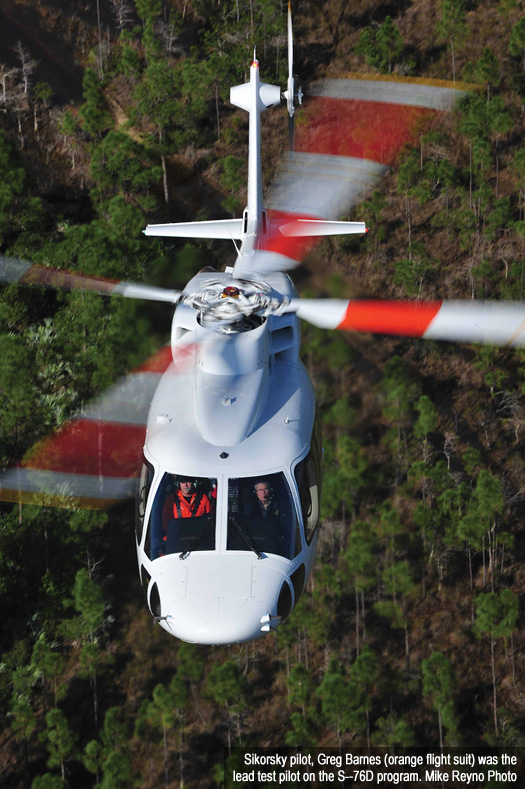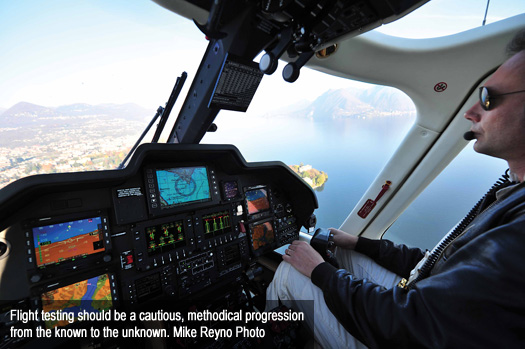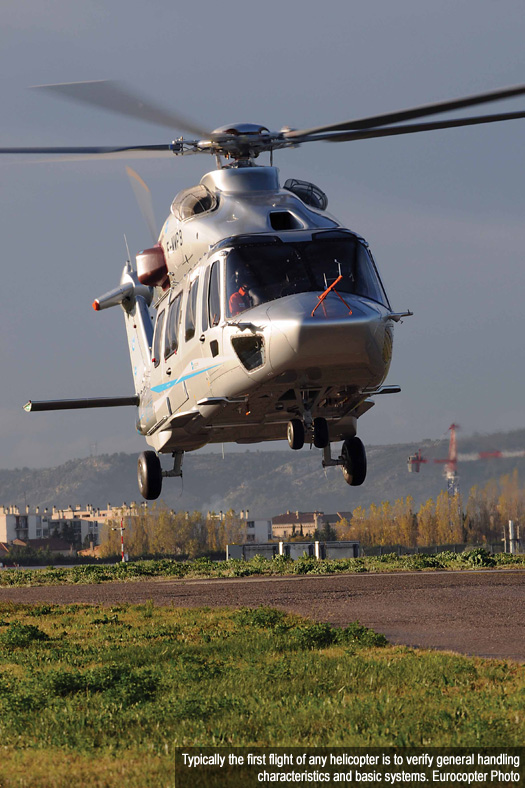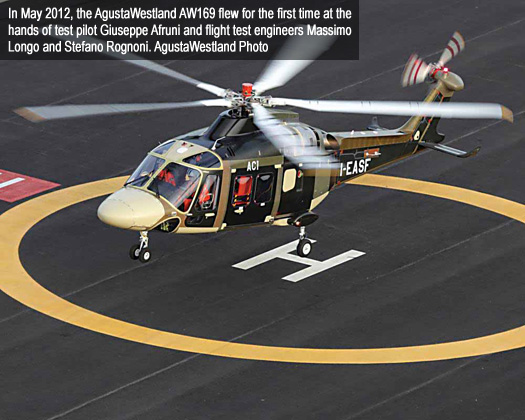
Making The Grade
The tests that a test pilot is required to safely accomplish vary with the type of testing. While this sounds a bit trite, it’s worthwhile noting that not all flight testing is the same. The pilot involved in the first flight of a helicopter is going to be looking for different things than the pilot who’s asked to assess whether the helicopter is safe for civil use, or effective for military use (two different and distinct things!), which in turn will be different than the pilot who is looking at new concepts of displays and controls.
Getting a New Type Into the Air
The pilot who is taking a completely new helicopter design for its first tentative escape from the grasp of Mother Earth may not be using any particularly new or interesting tests, but the task will require a lot of careful buildup. Just one example of care taken in these early stages is a test to ensure the engine fuel valve shuts off when it’s supposed to. It may sound simple, but it’s obvious that somewhere in the past, a fuel valve didn’t shut off when it was supposed to, likely with some unpleasant consequences. Perhaps next will be a test of the throttle to ensure it shuts off fuel to the fuel nozzle. Again, the logical explanation for this test is that at some point in the past, the throttle linkage wasn’t set up properly.

The first start of the engine may be without the rotor blades to ensure all the dynamic components are functioning properly. After the shutdown, you can bet that a small army of engineers and technicians swarm over the machine to see how things went. Once the rotors are installed, the helicopter is started and left to run at idle for some time, and this is again followed by a lengthy look at the equipment. Then, with the rotor at idle, the first tentative moves of the flight controls will be made — not just slow, smooth control movements with the collective fully down at idle, but very specific types of inputs — stick raps (fore/aft and lateral), small inputs of different speeds, and then inputs at different frequencies of control reversals. This is all then repeated at different collective settings. Once idle rotor RPM is cleared, increasing rotor speeds are subjected to the same precise tests. The aim is to weed out any nasty surprises that may be in store with the rotor blades on — before the aircraft leaves the ground.
Once the rotor RPM has been cleared, the test pilot will be ready to start thinking about getting airborne. At flight RPM, the collective pitch is increased slightly and the whole sequence of previous tests is repeated. Finally, the helicopter is ready for light on the skids — and once there, the pilot will try a small dance on the pedals just to see how they respond. Not only is the collective raised in small increments, it’s also lowered quickly to simulate a need to get rid of power. At long last, daylight appears between the landing gear and the ground.
Some Rules of Flight Testing1
The aim of all this buildup is one of the first rules of flight testing, which I like to state as:
NO SURPRISES!
Why? Flight testing should be a cautious, methodical progression from the unknown to the known. Each step should clearly identify what the next step should look like, and if something unexpected happens, it means someone has taken too large a bite.
The reason for testing the rapid reduction of power is to ensure you can meet the second rule of flight testing:
Always Leave an Out
Or, in other words, never go somewhere or do something from which you can’t easily escape. For example, once you’ve accelerated to an airspeed and stabilized there during the first adventure into forward flight, you must make sure you can return back to the hover from that speed. The rest of the exploration of the flight envelope and handling characteristics must be handled with the same degree of caution — there may be dragons lurking in some nasty corners, and the developmental test pilot has to be aware of these.

Flight test development is a three part process: Predict, then Test to Verify. And though it may sound pretty simple, this method will ensure that the first law — No Surprises — is met consistently.
“Predict,” means that engineers and technicians have worked out what should happen — what the response to an input should look like, or what the stress and strain on a component should be. “Test,” means we find a way to measure that, and can “Verify” that things are as expected. If not, the test is stopped until the reason for the mismatch between theory and reality is resolved. Sometimes this means that new test methods must be developed, and this will require some careful consideration by all concerned. This leads to the next major difference between operational flying and flight testing.
Lost in Translation?
Any development project for a new aircraft type is going to employ a large number of highly evolved specialists from a whole host of different disciplines. Design engineers of types you’ve probably never heard will be involved, and they don’t all speak the same technical language. Electrical engineers (and I’m not trying to put them down just because I didn’t understand imaginary numbers) don’t speak the same language as airframe structural engineers. The folks who seem to do the translation between all these disciplines are in flight test. An electrical system will have an influence on a whole host of other systems, such as hydraulics (for switching them on or off), or powerplants (how much power does it take to produce all those amps?) and so on. So the test pilot has to know enough about each system to be able to translate between all these folks. Though it’s not always easy, it is absolutely essential.
In operational flying, it’s relatively easy to see that nearly everyone involved (except perhaps the end customer) speaks the same language and knows what all the words mean.
More Tests
Having got the machine to the point where it can be safely flown, and completed all the thousands of steps necessary for obtaining a civil certification or military approval to fly, the next steps are done by the “certification” pilots. These pilots are trained in the various test techniques commonly used for evaluation, plus they have enough operational experience to be able to extrapolate their findings to the real world.
Another reason for having these types of pilots is so that you’ve got a sober second party looking at the helicopter and its foibles — because one of the traps that can snare a pilot in development is that sometimes test pilots know too much.

This is not to criticize the folks who do the development (and sometimes do the certification evaluation), but you wouldn’t want to test something without knowing everything you can possibly know before you test it, would you? And you wouldn’t want to have something happen without knowing exactly what you’re going to do when it happens (or doesn’t happen).
An example might be the failure of an electronic fuel control. In development, the pilot will be briefed in depth about the system to be fitted and tested. In order to test it, the pilot will know what the failure symptoms are, and exactly what to do when that failure occurs (meeting the first rule of flight testing — No Surprises). But the real world isn’t like that. Not all normal (let alone emergency) procedures are interpreted correctly, nor followed exactly. So what the test pilot knows and sees in carefully controlled conditions is probably not what the operational pilot sees in less-controlled circumstances. Therein lies the role of the certification (or military evaluation) test pilots.
These types of pilots are trained to consider all the operations of the helicopter and will put themselves into the shoes (flying boots?) of a junior pilot, flying operationally for long enough to perhaps need refresher training, on a rainy night at 3:30 a.m. with a load of unhappy passengers and lots of turbulence — and who is now faced with an emergency.
These pilots can interpret the regulations and specifications and determine if the helicopter and equipment can meet those dry and dusty tomes and be safe — and operationally effective.
Next issue: Why don’t we know more about this type of flying?
Shawn Coyle is currently director of academics for Marinvent Corp. and is a Transport Canada DAR flight analyst for helicopters. He has taught flight testing for over 10 years at three major test pilot schools, and certified entry-level simulators in Europe. With over 6,100 flight hours, including time in more than 30 different types of helicopters, he felt he had to write! The author of Cyclic and Collective and The Little Book of Autorotations (available through eagleeyesolutionsllc.com or Amazon.com) he also is involved as an expert witness on helicopters and regularly lectures at seminars and classes related to helicopters and aircraft certification.









